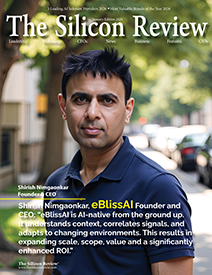30 Fastest Growing Tech Companies 2023
Benefit from best-in-class business intelligence and modern go-to-market strategies to build flexible services & products: Blazeclan
The Silicon Review
![]()
Blazeclan is a global leading cloud consulting and digital transformation partner for organizations. Blazeclan’s technology enthusiasts bring creative problem-solving ideas to the table for the digital transformation needs of businesses. Success for Blazeclan is when its customers maximize the company’s expertise for buoyant growth and endless opportunities to stay ahead of the pack. Migration to the cloud has become a mandate and not just a luxury for organizations to achieve operational agility, improve operational excellence, and drive value. Gartner, Inc estimates that by 2025, 85% of organizations will be cloud-first and 95% of the latest digital workloads will run on the cloud. There are broadly two ways an organization with legacy applications can leverage the cloud, cloud migration and modernization.
Difference between Cloud Migration and Cloud Modernization
While cloud migration involves the lift & shift of applications and moving the data to a cloud-native environment, cloud modernization focuses on re-architecting the legacy applications to remodeling those using cloud-native services. If an organization has legacy applications, it can opt for either.
Migrating legacy systems to the cloud may address short-term requirements, but operational challenges remain, which include consistent support, continuous monitoring, resource utilization, and software upgrades. The need for human and technological resources in cloud migration further adds to operational costs.
In cloud modernization, applications become the centerpiece. Re-architecting the applications involves component analysis, cloud-native service mapping, and leveraging cloud managed services to rebuild the applications for greater efficiency. The vertical learning curve, process disruption, and massive initial investment are upfront challenges facing cloud modernization. However, in the long run, organizations benefit from greater operational efficiencies.
Blazeclan’s cloud consultants and architects understand the business objectives, current status quo, IT landscape, and overall IT spending. Get a cloud roadmap post-workshop with CXOs, often tagged along by a cloud center of excellence team as a guide for the entire transformation journey.
Must-Follow Steps for an Ideal Cloud Migration
An imperative set of agendas, processes, and challenges exists for organizations moving from on-premises to the cloud. Keeping in sync with these can ensure a seamless and hassle-free transition to the cloud. Let’s dive into the steps of achieving an ideal migration to the cloud.
Define Desired Outcomes
Aligning the immediate and short-term business outcomes with the cloud migration roadmap must be the first step. Decommissioning the data center, adding new technologies to the infrastructure, leveraging tools to rev up customer experience, improving system performance, and realizing better cost optimization can be some of the many outcomes any organization would consider before its move to the cloud. In addition, prioritizing these outcomes helps choose the right cloud provider and an accurate deployment model for achieving a smooth transition.
Assess the Existing Environment
Having a keen eye on the technologies that are being used and the way they are being used is indispensable. Assessing the existing environment gives a 360-degree view of current operations and insights into achieving a seamless transition to new processes. The types of applications, infrastructure, hardware, tools, technologies, data compliance, and the comparison between current & possible future investments are some questions to keep in mind while assessing the existing environment.
Identify Which Applications to Migrate
An exhaustive assessment of the existing applications and their architecture gives insights into some areas, such as the functioning compatibility of applications in the cloud, the need for refactoring, the costs involved, and security considerations. It allows the organizations to set aside the applications that are ready for cloud migration and work on those that need to be made cloud-ready.
Record Base Performance Standard
Having a clear picture of where it stands and comparing the milestones with that base performance can help an organization understand the pain points of its existing infrastructure and underperforming areas. It enables tracking the in-progress migration performance while determining an ETA for a successful and complete migration.
Make the Applications Ready for Cloud Migration
Lift & shift and refactor are two primary choices when moving the applications from on-premises to the cloud. While lift & shift moves applications as is to the cloud, refactoring modifies the architecture to benefit from cloud-native capabilities. Advanced planning is necessary for refactoring as it is time-intensive and adds to upfront costs, particularly when legacy applications are involved. On the other hand, any modification to run the applications in the cloud through lift & shift is just enough.
Migration Execution
Migrating the applications first with the lowest complexity is the best practice to prevent or reduce potential downtime. Few organizations choose the parallel operation model, which involves maximizing on-premises and cloud-based applications both. The end of the line is to have a perfect sense of
- applications migrated
- where they go
- Their performance in the new cloud environment.
The intensity of caution is directly proportional to the complexity of the application architecture.
Continuous Monitoring and Ongoing Maintenance
Implementing monitoring and maintenance processes determines the ongoing success of operations in the new environment. Multi-dimensional testing, reviewing updates & security patches, making application/software upgrades, conducting performance monitoring, application-level testing, and load testing is crucial despite how seamless the migration was. It ensures that everything continues to run in a smooth, consistent manner.
Either migrate or redeploy the applications using insights from consulting phase. Start with creating a secure cloud landing zone, followed by migration and deployment. Leverage Blazeclan’s proprietary frameworks that include robust automation to achieve an agile migration supported by pre-defined technical artifacts.
Varoon Rajani, Founder & Chief Executive Officer

_2025-12-15_12-44-58.webp)

_2025-11-17_06-38-14.webp)

 (1)_2025-10-21_13-35-14.webp)